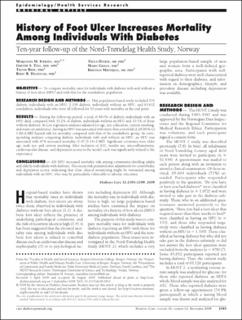| dc.identifier.citation | Iversen, M. M., Tell, G. S., Riise, T, Hanestad, B. R., Østbye, T., Graue, M. & Midthjell, K. (2009b). A history of foot ulcer increases mortality among persons with diabetes. 10 year follow-up of the Nord-Trøndelag Health Study, Norway. Diabetes Care, 2(12), 2193–9. | en_US |
| dc.description.abstract | OBJECTIVE To compare mortality rates for individuals with diabetes with and without a history of foot ulcer (HFU) and with that for the nondiabetic population.
RESEARCH DESIGN AND METHODS This population-based study included 155 diabetic individuals with an HFU, 1,339 diabetic individuals without an HFU, and 63,632 nondiabetic individuals who were all followed for 10 years with mortality as the end point.
RESULTS During the follow-up period, a total of 49.0% of diabetic individuals with an HFU died, compared with 35.2% of diabetic individuals without an HFU and 10.5% of those without diabetes. In Cox regression analyses adjusted for age, sex, education, current smoking, and waist circumference, having an HFU was associated with more than a twofold (2.29 [95% CI 1.82–2.88]) hazard risk for mortality compared with that of the nondiabetic group. In corresponding analyses comparing diabetic individuals with and without an HFU, an HFU was associated with 47% increased mortality (1.47 [1.14–1.89]). Significant covariates were older age, male sex, and current smoking. After inclusion of A1C, insulin use, microalbuminuria, cardiovascular disease, and depression scores in the model, each was significantly related to life expectancy.
CONCLUSIONS AN HFU increased mortality risk among community-dwelling adults and elderly individuals with diabetes. The excess risk persisted after adjustment for comorbidity and depression scores, indicating that close clinical monitoring might be warranted among individuals with an HFU, who may be particularly vulnerable to adverse outcomes.
Hospital-based studies have shown that mortality rates in individuals with diabetic foot ulcers are about twice those observed in individuals with diabetes without foot ulcers (1,2). A diabetic foot ulcer reflects the presence of underlying pathological conditions, and the risk of recurrent ulcers is high (3,4). It has been suggested that the elevated mortality rate among individuals with diabetic foot ulcers is related to comorbid disease such as cardiovascular disease and nephropathy (5) or to psychological factors including depression (6). Although the mortality rate in individuals with diabetes is high, no large population-based studies have examined the impact on mortality of a history of foot ulcers (HFU) among individuals with diabetes.
The purpose of this study was to compare mortality rates for individuals with diabetes reporting an HFU with those for individuals without an HFU and the nondiabetic population. These issues were investigated in the Nord-Trøndelag Health Study (HUNT 2), which includes a very large population-based sample of men and women from a well-defined geographic area. Participants with self-reported diabetes were well characterized with regard to their diabetes, and information on demographics, lifestyle, and prevalent disease including depression was available. | en_US |

